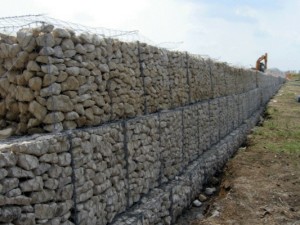
An electric fence is a barrier that uses electric shocks to deter animals from crossing a boundary. The voltage of the shock may have effects ranging from discomfort to death. Most electric fences are used today for agricultural fencing and other forms of animal control, although they are frequently used to enhance the security of sensitive areas, such as military installations, prisons, and other security sensitive places; places exist where lethal voltages are used.
Design and function
Electric fences are designed to create an electrical circuit when touched by a person or animal. A component called a power energizer converts power into a brief high voltage pulse. One terminal of the power energizer releases an electrical pulse along a connected bare wire about once per second. Another terminal is connected to a metal rod implanted in the earth, called a ground or earth road. A person or animal touching both the wire and the earth during a pulse will complete an electrical circuit and will conduct the pulse, causing an electric shock. The effects of the shock depend upon the voltage, the energy of the pulse, the degree of contact between the recipient and the fence and ground and the route of the current through the body; it can range from barely noticeable to uncomfortable, painful or even lethal.
Fence Energizers
Early alternating current (AC) fence chargers used a transformer and a mechanically driven switch to generate the electrical pulses. The pulses were wide and the voltage unpredictable, with no-load peaks in excess of 10,000 volts and a rapid drop in voltage as the fence leakage increased. The switch mechanism was prone to failure. Later systems replaced the switch with a solid-state circuit, with an improvement in longevity but no change in pulse width or voltage control.
“Weed burner” fence chargers were popular for a time and featured a longer-duration output pulse that would destroy weeds touching the fence. These were responsible for many grass fires when used during dry weather. Although still available, they have declined in popularity.
Most modern fences emit pulses of high voltage at a given interval of time, and don’t take into account whether there is an animal or person touching the conductive wires, except for the voltage multiplier based electric fence charger that stores high voltage potential and dumps its charges as soon as a conductive load (grounded animal/person) touches the wires.
Depending on the area to be fenced and remoteness of its location, fence energizers may be hooked into a permanent electrical circuit, they may be run by lead-acid or dry cell batteries, or a smaller battery kept charged by a solar panel. The power consumption of a fence in good condition is low, and so a lead-acid battery powering several hundred meters of the fence may last for several weeks on a single charge. For shorter periods dry cell batteries may be used. Some energizers can be powered by more than one source.
Fencing materials
Smooth steel wire is the material most often used for electric fences, ranging from a fine thin wire used as a single line to thicker, high-tensile (HT) wire. Less often, woven wire or barbed wire fences can be electrified, though such practices create a more hazardous fence, particularly if a person or animal becomes caught by the fencing material (electrified barbed wire is unlawful in some areas). Synthetic webbing and rope-like fencing materials woven with fine conducting wires (usually of stainless steel) have become available over the last 15 to 20 years, and are particularly useful for areas requiring additional visibility or as temporary fencing.
The electrified fence itself must be kept insulated from the earth and from any materials that will conduct electricity and ignite or short out the fence. Fencing must, therefore, avoid vegetation, and cannot be attached directly to wood or metal posts. Typically, wooden or metal posts are driven into the ground and plastic or porcelain insulators are attached to them, or plastic posts are used. The conducting material is then attached to the posts.
Electrified palisade fences are usually made from painted mild steel, galvanized steel, stainless steel or aluminum. Typically the fences are 2.4 meters (7 ft 10 in). The palisade fence is mechanically stronger than a typical steel cable electric fence to withstand impact from wildlife, small falling trees, and wildfires.
Sources – Wikipedia


